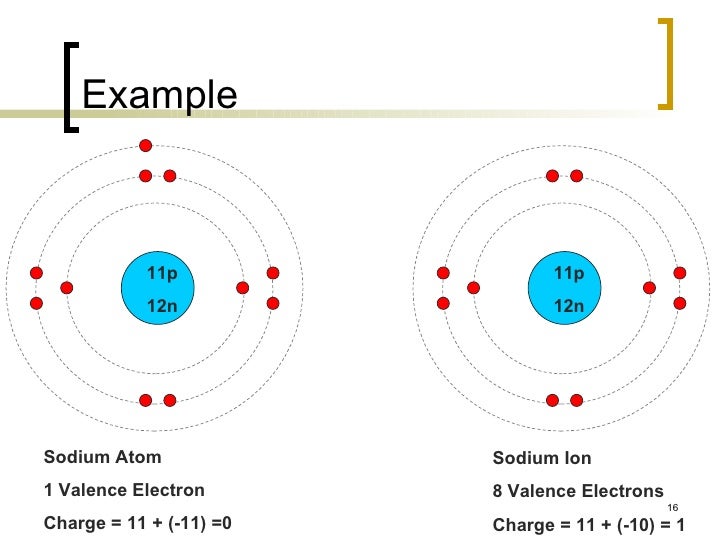Valence electrons are those electrons in the outer shell of a given atom, the number of which determines how atoms interact with each other. An atom is said to have a closed shell when it has enough valence electrons in order to make it stable; when there are not enough, it is said to have an open shell. An atom with an open shell is constantly trying to reach stability, forming one of the foundations of many chemical reactions.
Sodium gives up a valence electron to chlorine, creating an ionic bond that makes salt. The affinity for atoms to achieve stability by gaining or losing valence electrons provides a foundation for two types of chemical bonds: the ionic bond and the covalent bond. Sodium (Na), for example, has one electron in its valence shell. This is an unstable state because that valence shell needs eight electrons to be full. In order to fill its valence shell, sodium has two options: Find a way to add seven electrons to its valence shell,.

An atom is reactive or inert depending on how many valence electrons it has. The most reactive atoms are those that have one or two to lose or those that have one or two to gain in order to maintain stability. For this reason, the noble gases — all of which have a closed outer shell in nature — are chemically inert. In general, eight electrons are needed for an atom to reach stability. Two notable exceptions are hydrogen and helium, both of which need two to make a closed shell.
The affinity for atoms to achieve stability by gaining or losing valence electrons provides a foundation for two types of chemical bonds: the ionic bond and the covalent bond. Ionic bonds are formed when one atom “steals” an electron from another. Table salt (NaCl) is an example of this. Sodium (Na) has one electron to give up. Chlorine (Cl), on the other hand, needs one to be complete.
- Valence electrons are the outermost electrons, and are the ones involved in bonding. Sodium has 11 electrons: its atomic number is 11, so it has 11 protons; atoms are neutral, so this means sodium also has 11 electrons. Electrons are arranged in 'shells' or energy levels.” 3.1K views.
- A sodium atom, which has 11 protons and 11 electrons, has a single valence electron in its 3s subshell. A chlorine atom, which has 17 protons and 17 electrons, has seven valence electrons in its third shell, represented as 3s 2 3p 5. In forming an ionic bond, the sodium atom, which is electropositive, loses its valence electron to chlorine.
To reach stability, chlorine will take an electron from sodium. This allows both elements to achieve a closed shell and stability. The result of this is that the sodium atom becomes a positive ion and the chlorine atom becomes a negative ion. The opposite charges will then attract each other. When in a solution, these molecules also conduct electricity, since ions are free to move around in the solution.
Water is an example of atoms forming a covalent bond. Hydrogen has one atom to gain or lose and oxygen needs two to achieve stability. In this application, however, the oxygen does not steal the electrons from the two hydrogen atoms. Rather, the oxygen and the two hydrogen atoms share the electrons, forming a water molecule. Atoms can also use covalent bonds to share electrons with atoms of the same element, such as in a hydrogen molecule (H2).
Click to see full answer
Sodium Valence Electrons Gain Or Lose
Accordingly, how many energy levels does sodium have?
Period 3. Explain that sodium has 11 protons and 11 electrons. There are 2 electrons on the first energy level, 8 electrons on the second level, and 1 electron on the third energy level. Explain that the second energy level can only have 8 electrons so the next electron in sodium has to be on the next (third) level.
Also Know, what is an energy level on the periodic table? Energy LevelsIt is the outermost electrons that determine the chemical properties of the element. In looking at a diagram of an atom, note that the nucleus is fairly centrally located. The energy levels are built up from the level closest to the nucleus outward.
Accordingly, how many energy levels does beryllium have?

So for the element of BERYLLIUM, you already know that the atomic number tells you the number of electrons. That means there are 4 electrons in a beryllium atom. Looking at the picture, you can see there are two electrons in shell one and two in shell two.

Why does sodium have 12 neutrons?
Periodic Table Valence Electrons
It's because sodium atoms each have 11 protons, with a mass of 1, and 12 neutrons, with a mass of 1. Answer 3: Most sodium atoms contain twelve neutrons.
